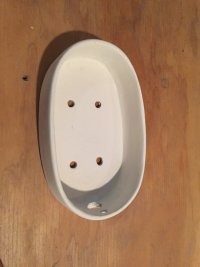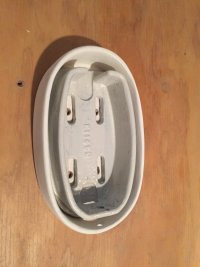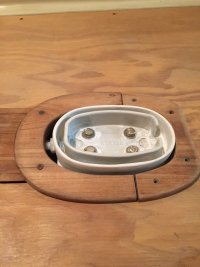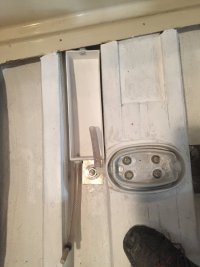I know many of us have the issue of fresh water entering the bilge and it is often suspected to be coming down the mast. The other weekend while on board during a heavy downpour I witnessed this first hand water running down the inside of the mast. Now I know that there’s no way it’s coming down from the mast head or through the sheave ports unless it rains horizontally. So this got me thinking and my guess is rain water is running down the mast and entering where the spreader bars enter the mast as they are slightly angled upward and would capture the rain. So when I unstep at haul out this fall I’m going to look to silicone seal the spreader bars where they enter the mast. Comments?
Guest viewing is limited
- You have a limited number of page views remaining
- 20 guest views remaining
- Register now to remove this limitation
You are using an out of date browser. It may not display this or other websites correctly.
You should upgrade or use an alternative browser.
You should upgrade or use an alternative browser.
Water in the bilge
- Thread starter kiwisailor
- Start date
Our stock Kenyon spar has always admitted rain water from any storm. Worse when there is wind. Consider that the masthead has multiple sheave openings, plus the sheave box for the topping lift. Double spreaders with their mast piercings. Halyard exit openings. The harder the wind blows the rain sideways, the more of it drips down the inside. After a good storm, I can remove over a pint from the bilge.
Out of curiosity, what gives you confidence the water isn't entering through your masthead?
I'm in the middle of rehabbing mine, and at the top where the anchor light mounts, and the radio antenna coax exits, and where I intend to mount an anemometer, etc. there are many existing holes, some of which are ill-patched. The mounting plate I found was machine-screwed on, but no attempt had been made (or remained) to waterproof the joint between the plate and the masthead casting.
For reference, this is an Isomat masthead.
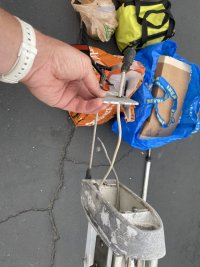
I'm in the middle of rehabbing mine, and at the top where the anchor light mounts, and the radio antenna coax exits, and where I intend to mount an anemometer, etc. there are many existing holes, some of which are ill-patched. The mounting plate I found was machine-screwed on, but no attempt had been made (or remained) to waterproof the joint between the plate and the masthead casting.
For reference, this is an Isomat masthead.

"Mast Water," winner, Very Short Documentary Prize, Cannes Flim (Flam) Festival.
Out of curiosity, what gives you confidence the water isn't entering through your masthead?
I'm in the middle of rehabbing mine, and at the top where the anchor light mounts, and the radio antenna coax exits, and where I intend to mount an anemometer, etc. there are many existing holes, some of which are ill-patched. The mounting plate I found was machine-screwed on, but no attempt had been made (or remained) to waterproof the joint between the plate and the masthead casting.
For reference, this is an Isomat masthead.
“Confidence“ is my mast head is totally different the top is welded onto the mast itself and not bolted. Also I have to unstep my mast everytime I haul out for winter so my mast gets close inspection, all mast head wiring is sealed and have drip loops. So I’m fairly confident that the upward slant of the spreader bars that pass through the mast are the major source of rain getting inside the mast. I’m leaning towards sealing them and seeing how well that works next season.
Interesting, all my mast wiring passes directly through the mast step into the bilge then through the limber holes back to the nav station area. I have a small inspection plate on the side of the mast approximately 2ft from the base that I can squeeze my hand into and unplug all my mast head wiring connections there. When you unstep every year waterproof plugs make it much easier to disconnect/connect wiring than terminal strips and insulation tape etc."Mast Water," winner, Very Short Documentary Prize, Cannes Flim (Flam) Festival.
It seems like you have good reasons to be confident. For most California boats, it seems like pulling the mast is a novelty since we can let the boats float 12 months per year.“Confidence“ is my mast head is totally different the top is welded onto the mast itself and not bolted. Also I have to unstep my mast everytime I haul out for winter so my mast gets close inspection, all mast head wiring is sealed and have drip loops. So I’m fairly confident that the upward slant of the spreader bars that pass through the mast are the major source of rain getting inside the mast. I’m leaning towards sealing them and seeing how well that works next season.
Given that you are doing it every season - maybe you have a pointer for me on the following:
Do you rely on a mast boot for waterproofing? I think the previous owner of my boat was having problems and pumped a ridiculous amount of silicon around the mast entry point. (Picture shows the silicon with my decaying mast boot already removed.) How are you stopping water from getting in around the mast each year?

1911tex
Sustaining Member
Tom: Suggestion: Unscrew those 10 screws holding down the base (some may not be tight)...lift the base and seal up underneath, then seal the screw threads before screwing them down. I didn't have screws, just lag bolts...did that job and the mast leaks were reduced 70% ! Water under the base leaching down the screw holes and down the mast! Pressure from the halyards/sheets pulling the base one side to the other over time...job should not take 30 minutes. An easier, sloppier way just border under the base with silicone, but still seal the screw threads.
It seems like you have good reasons to be confident. For most California boats, it seems like pulling the mast is a novelty since we can let the boats float 12 months per year.
Given that you are doing it every season - maybe you have a pointer for me on the following:
Do you rely on a mast boot for waterproofing? I think the previous owner of my boat was having problems and pumped a ridiculous amount of silicon around the mast entry point. (Picture shows the silicon with my decaying mast boot already removed.) How are you stopping water from getting in around the mast each year?
View attachment 34832
Yes, all that silicone is unnecessary. Any of the standard mast boot systems work fine. I use the stretchy tape, covered by a Sunbrella boot against UV. Tex may be right that your collar leaks and needs sealing. But a mast just needs a boot. They all leak from inside anyway.
67rway
Member II
I'm a relative newbie, but my belief is to both reduce and manage a water leak, rather than to eliminate it.
So... I did my due diligence regarding extraneous holes, resealing the mast partners deck plate(Cliff's Notes version), and using the stretchy mast tape Christian mentioned, but also opted for a mast sump as shown.
Solid (FRP) under the mast, epoxy glassed to an oval piece formed from the mast. Set up to plumb to a gulper pump that I installed to direct shower water through a thru hull.
So... I did my due diligence regarding extraneous holes, resealing the mast partners deck plate(Cliff's Notes version), and using the stretchy mast tape Christian mentioned, but also opted for a mast sump as shown.
Solid (FRP) under the mast, epoxy glassed to an oval piece formed from the mast. Set up to plumb to a gulper pump that I installed to direct shower water through a thru hull.
Attachments
I have had a PSS shaft seal for over 20 years, and with your nifty rain catcher, a bilge would *never* see any water. That's pretty cool.
This must have raised the spar about a quarter inch, so the turnbuckles would all need to be slightly un-screwed. (?)
Tradition question: did you add (or replace) a coin under the mast?

This must have raised the spar about a quarter inch, so the turnbuckles would all need to be slightly un-screwed. (?)
Tradition question: did you add (or replace) a coin under the mast?
mizunoman101
Member I
Bravo! Bravo!!!!"Mast Water," winner, Very Short Documentary Prize, Cannes Flim (Flam) Festival.

